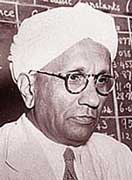|

|
Alphabetical Order
|

|
|
|
 Chandrasekhar Venkata Raman or C.V.R. as he was popularly known as, was born on November 7, 1888, in Tiruvanaikkaval, Tamil Nadu. He acquired his bachelor's degree from Presidency College, University of Madras, and published his first paper in the Philosophical Magazine at the age of 18. Despite passing his MA in 1907 with flying colours, he could not study further in England due to health problems.
Chandrasekhar Venkata Raman or C.V.R. as he was popularly known as, was born on November 7, 1888, in Tiruvanaikkaval, Tamil Nadu. He acquired his bachelor's degree from Presidency College, University of Madras, and published his first paper in the Philosophical Magazine at the age of 18. Despite passing his MA in 1907 with flying colours, he could not study further in England due to health problems.
For the same reason he dropped the idea of taking the Indian Civil Service exam as at that time one had to travel to England to appear for it. However, he passed the Financial Civil Services exam. During his 10 years in the Indian Finance Department, he continued his research and published about 30 papers.
He took voluntary retirement from government service in 1917 for the Palit Chair in Physics in Calcutta University offered to him by Sir Ashutosh Mukherji. Raman had a special interest in the optics of colloids and the physiology of human vision. He studied the structure and properties of diamonds and the structure and optical behaviour of iridescent substances like agate, opal and pearls. In 1930 he won the Nobel Prize in physics for the discovery of the Raman Effect.
|




 Chandrasekhar Venkata Raman or C.V.R. as he was popularly known as, was born on November 7, 1888, in Tiruvanaikkaval, Tamil Nadu. He acquired his bachelor's degree from Presidency College, University of Madras, and published his first paper in the Philosophical Magazine at the age of 18. Despite passing his MA in 1907 with flying colours, he could not study further in England due to health problems.
Chandrasekhar Venkata Raman or C.V.R. as he was popularly known as, was born on November 7, 1888, in Tiruvanaikkaval, Tamil Nadu. He acquired his bachelor's degree from Presidency College, University of Madras, and published his first paper in the Philosophical Magazine at the age of 18. Despite passing his MA in 1907 with flying colours, he could not study further in England due to health problems.